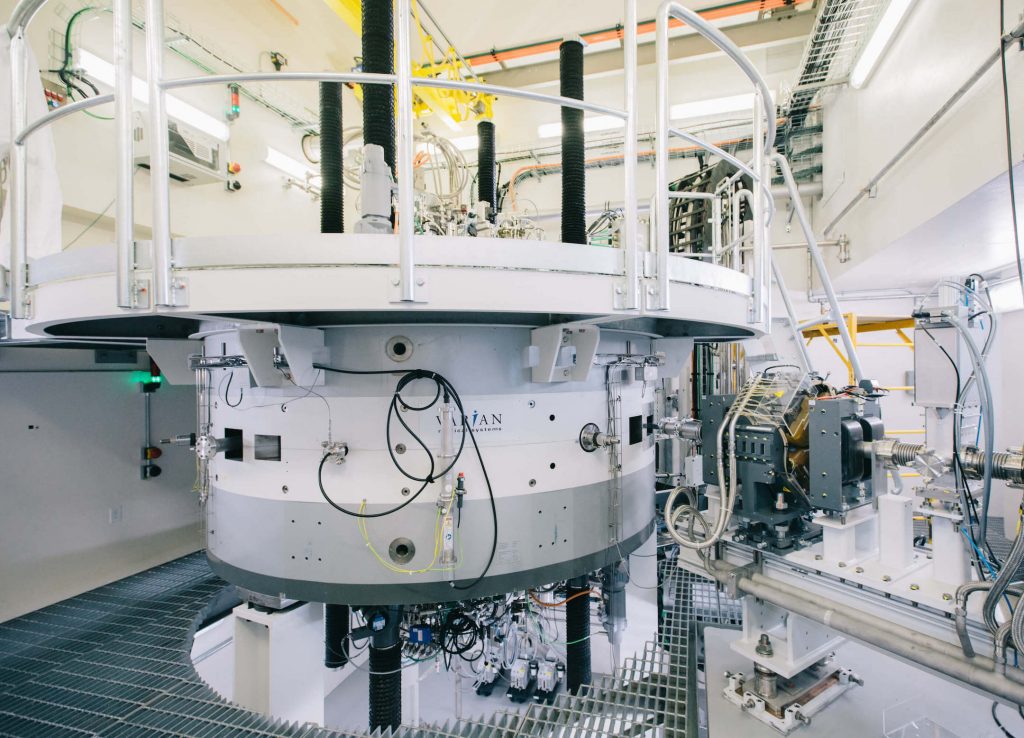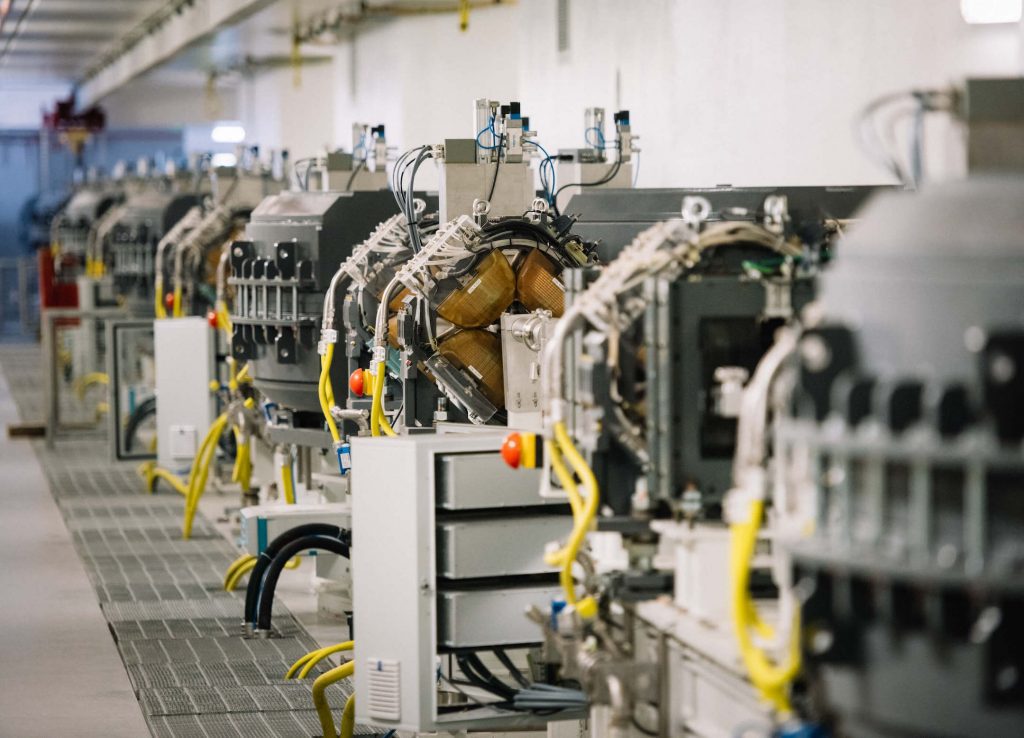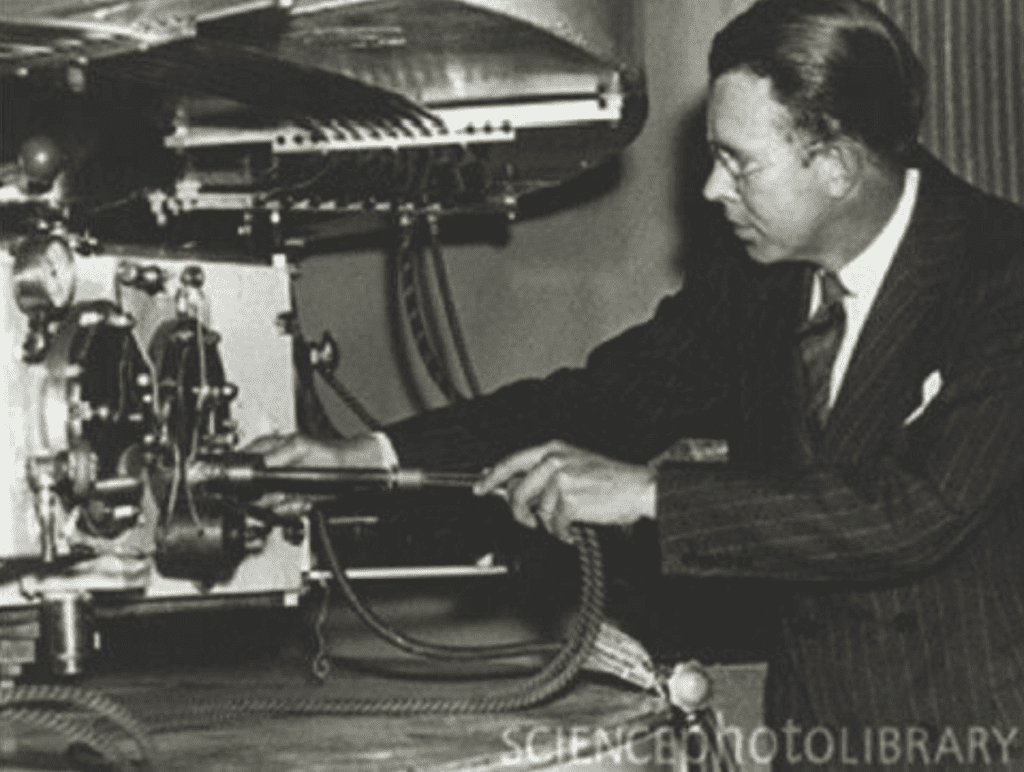Proton therapy is an advanced form of radiation that uses positively charged particles, or protons to precisely target tumors. At Emory Proton Therapy Center, we use pencil beam scanning (PBS), also known as Intensity-Modulated Proton Therapy (IMPT), the most precise and advanced method of delivering proton therapy available today.
Unlike many centers that offer older techniques, PBS technology “paints” the tumor spot by spot and layer by layer, shaping the dose to match the tumor’s exact size, shape, and depth. This level of accuracy helps protect nearby healthy tissue and critical organs.
And because protons release most of their energy inside the tumor and then stop, they deliver no exit dose, unlike X-rays, which pass through the body. That means fewer side effects, especially for tumors near sensitive structures like the brain, spine, heart, or eyes.
PBS is not available at all proton centers, but it is the standard of care here.
Proton Therapy vs. X-ray Radiation
Pencil Beam Proton Therapy
- Uses protons, positively charged subatomic particles with mass
- Releases most radiation in the tumor, then stops
- Better protects healthy tissue and organs
- Ideal for complex or sensitive areas
- Available only at select proton centers
TRADITIONAL X-RAY RADIATION
- Uses photons (X-rays) with no mass
- Releases radiation before and after the tumor
- Higher risk of damaging surrounding tissue
- Less precise near critical structures
- Widely available
Who Is a Candidate For Proton Therapy Treatment
The Emory Proton Therapy Center provides patients with the latest proton treatment technology combined with the expertise of renowned specialists at Winship Cancer Institute of Emory University. Patients benefit from extensive and multidisciplinary evaluation and treatment, access to clinical trials, and other advanced therapies and approaches.
The best way to determine if proton therapy is a good treatment option for you is to meet one of our radiation oncologists in consultation or be seen in one of our multi-disciplinary clinics. During a consultation visit, your doctor will work with you to develop an overall plan of care, discuss all radiation treatment options, including proton therapy, discuss the details of treatment, including the potential risks and side effects, and answer questions.
Proton therapy is merely one of Emory’s cancer treatment tools at Winship. Our multidisciplinary team will look at your case, compare the benefits and risks of different treatment options, and then recommend what may work best for you.

Get a Second Opinion
Choosing the right cancer treatment is an important decision. If you want another doctor’s opinion about your care options, we offer second opinion consultations at Emory Proton Therapy Center and through our cancer clinics at Winship.
Getting a second opinion is straightforward. Call 833-377-6866 to request a consultation. We offer video consultations for patients in Georgia, with full in-person visits available if you decide to pursue proton therapy.
What To Expect During Proton Therapy Treatment
Preparation and Planning for Proton Therapy
Your journey begins with a detailed consultation where we review your medical history and discuss whether proton therapy is the right fit for you. Next, we will guide you through a simulation using advanced imaging, like a CT or MRI scan, to map out a personalized treatment plan with exceptional precision.
This preparation phase also includes a thorough conversation about what to expect during treatment, including any possible side effects. Our team is here to ensure you’re informed, supported, and confident moving forward.
Treatment Process and Timeline
Proton therapy is typically delivered over several weeks. Each daily session lasts about 30 minutes, though the actual treatment only takes a few minutes. Most of your time is spent carefully positioning you to ensure pinpoint accuracy.
Throughout your treatment, you will have weekly check-ins with your care team to monitor your progress and make any needed adjustments. Regular imaging and quality checks help ensure the treatment stays precisely on target.
Side Effects and Managing Them
One of the key advantages of proton therapy is its ability to reduce side effects compared to traditional radiation. However, side effects vary based on the location and type of tumor.
During your initial consultation, we will talk through any risks and help you understand what to expect. As you go through treatment, our compassionate team will be by your side to help manage any side effects and make sure you’re as comfortable as possible.
Request a Consultation
Why Choose Proton Therapy
Proton therapy offers several important advantages over traditional radiation, especially when precision, safety, and long-term quality of life matter. At Emory Proton Therapy Center, we use pencil beam scanning, the most advanced method available, to deliver treatment with sub-millimeter accuracy while minimizing harm to healthy tissue.
Fewer Side Effects During Treatment
By reducing or avoiding radiation to normal areas, proton therapy may reduce some side effects during and after the treatment course, like difficulty swallowing for head and neck patients, urinary or bowel problems for prostate cancer patients and inflammation or damage to the heart or lung for treatment of the chest or breast.
Better Quality of Life During and After Treatment
Treatments are non-invasive, painless, and typically quick. Many patients are able to continue working, caring for family, and maintaining normal routines throughout care. With fewer side effects, recovery can also be faster, helping patients get back to life sooner.
Lower Risk of Long-Term Side Effects
Because proton therapy avoids unnecessary radiation to nearby tissues, it may reduce the risk of serious long-term complications, including, damage to the heart, lungs, or salivary glands, developmental issues (in children), radiation-induced secondary cancers. Our goal is not just effective treatment, it is protecting your health long after treatment ends.
A Safer Option for Children
Children are especially sensitive to radiation, and even small doses to healthy tissue can affect their growth and development. Proton therapy allows us to treat pediatric cancers while reducing the risk of long-term side effects. That is why it is often the preferred approach for treating children.
Effective for Complex or Sensitive Tumors
Proton therapy is often used to treat complex or irregularly shaped tumors that are in close proximity to vital organs, critical structures, or important healthy tissue.
An Option for Recurrent Tumors
In some cases, proton therapy may be used to treat tumors that have recurred after prior radiation treatment, a situation in which other types of radiation may not be a good option.
Less Radiation to Healthy Tissue
Unlike traditional radiation, proton beams release most of their energy inside the tumor, then stop. This targeted delivery helps reduce unnecessary exposure to healthy tissue and organs. With pencil beam scanning, we take that precision even further, “painting” the tumor layer by layer, and helping you heal with fewer side effects.
The Technology Behind Proton Therapy
At Emory Proton Therapy Center, treatment is not just precise, it is powered by some of the most advanced cancer-fighting technology in the world. Every part of the system is engineered for one purpose: to deliver radiation with sub-millimeter accuracy, while protecting healthy tissue.
Cyclotron: Where Proton Therapy Begins
Proton therapy starts in a 90-ton superconducting cyclotron. A powerful machine that accelerates protons to nearly 60% of the speed of light (that’s over 110,000 miles per second). This energy gives the proton beam enough force to reach tumors deep within the body. A specialized energy selection system adjusts the speed and depth of the beam to match each patient’s tumor with pinpoint accuracy.

Beamline: Guiding the Beam with Precision
After acceleration, the proton beam travels through a long vacuum tube called a beamline. Along the way, powerful magnets steer and shape the beam so it remains tightly focused until it reaches the treatment room.

Gantry: Precision from Every Angle
In most treatment rooms, the proton beam is delivered through a three-story rotating gantry that can move 360 degrees around the patient. This allows the care team to treat the tumor from multiple directions, maximizing precision and sparing surrounding tissue.
Each gantry is equipped with:
- Cone-beam CT imaging, to visualize the tumor in 3D and ensure the patient is aligned correctly
- Low-dose X-rays, to confirm positioning before every session

Fixed-Beam Room: Built for Prostate Cancer
One of our rooms is specially designed for prostate cancer and other tumors treated with a fixed beam. Instead of the beam rotating, the patient is gently positioned using a robotic couch to achieve the best treatment angles. Like all our rooms, it includes advanced imaging to ensure accurate delivery.
Pencil Beam Scanning: Our Standard in Every Room
Unlike older forms of proton therapy, all of our treatment rooms use pencil beam scanning (PBS), also known as Intensity-Modulated Proton Therapy (IMPT). PBS delivers radiation in a fine stream, “painting” the tumor layer by layer.
This allows us to:
- Target tumors of nearly any shape
- Adapt treatment to complex anatomy
- Spare nearby healthy tissue with exceptional accuracy
Not all proton centers offer this level of precision, but at Emory, it is our standard.
The History of Proton Therapy
In the early 1900s, Nobel-prizewinning physicist Ernest Rutherford discovered the nucleus or center of an atom and proposed the name “proton” for the positively-charged particles in the nucleus. Another Nobel-prize winning physicist William Bragg described the unique way that particles, like protons, deposit their energy. Unlike photons (X-rays), which have decreasing energy deposition with increasing depth of penetration, particles like protons have a sharp increase in energy deposition near the end of their range followed by a sharp drop off. This phenomenon is called the Bragg peak in his honor, and is the reason why proton therapy often results in less radiation to normal tissues outside of targets compared to photon therapy.
In 1930, Ernest Lawrence, yet another Nobel-prize winner, invented the cyclotron, which could generate a high-energy stream of protons and greatly advanced research in particle physics. The cyclotron continues to be widely used in medicine, for example to create radionuclides for imaging and for proton therapy. The physicist Robert Wilson, who studied with Dr. Lawrence, proposed the use of proton therapy for treatment of cancer in a 1946 paper, describing the advantages compared to photons and outlining many of the early techniques used for proton treatment. The first proton therapy patient treatments were begun in 1954 in nuclear physics research facilities.

For many decades, proton therapy remained limited to just a few centers and was often used to treat rare and challenging tumors. The U.S. Food and Drug Administration approved proton therapy in 1988. Improvements in imaging, engineering and computer technology enabled the development of pencil-beam scanning proton therapy, which greatly improved upon early forms of proton therapy and increased the interest in proton therapy to treat more diseases. These improvements led to more widespread investment in proton therapy technology in the US and across the world to serve more patients. In 2005, there were just four proton centers operating in the United States, which grew to 10 by 2010, and as of 2024 there were 46. According to statistics compiled by the Particle Therapy Co-Operative Group, as of the end of 2024, proton therapy had been used in the treatment of over 450,000 people worldwide. The Emory Proton Therapy Center treated its first patients on December 4, 2018.